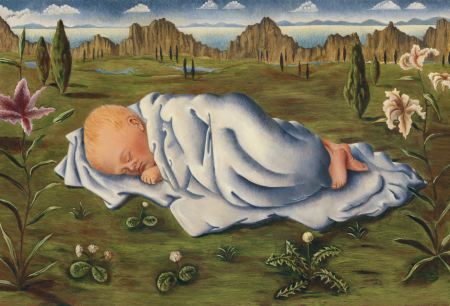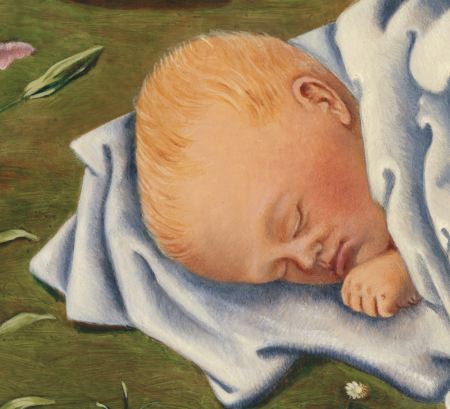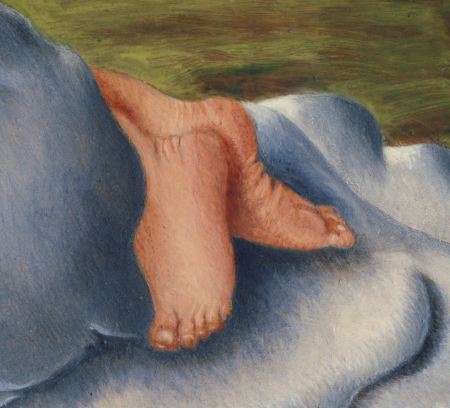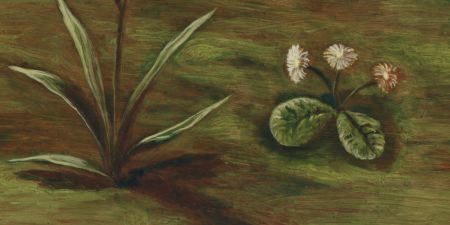
This painting of Françesca I made when pregnant with Nino (Fran was one year old then). We were living in Germany and I painted only an hour or two each day because I was too tired to sit longer (I was really big at that point).
It is based on drawings of Françesca sleeping, combined with my imagination. I find it wonderful to paint people.
Before I committed myself to still life painting I was working together with Karl using his rediscovered techniques of the old masters.
That is how I learned to use the different layers of paint in a simple and logical way.
I used to paint from my imagination, now I seem to have left that behind. How do you balance between reality and fantasy in your work?

. . .
Here are some technical details about the painting.
Important to me in working with Karl was that I learned how to make a drawing and bring it on to an oak panel with a gesso made from rabbit skin glue and chalk.
On that you needed to draw for days and days and than also work on it with ink and a brush and still make changes.
When the drawing finally was finished the panel was ready for the underpainting. And that is as I already said a simple and logical process:
first the sky that was under-painted with azurite , white and ochre,
- than the earth : under-painted with (a reddish color )
- then the foliage : also a reddish under-painting
- the skin color as close to the skin color as posible but a little warmer?
- the cloth covering the baby I first under-painted it pink because I thought I wanted it to be over-painted with lapis lazuli
- the under-painting of the left flower was blue with azurite the other one ocre.
Thus the process of under-painting was finished.
Karl and I where always surprised about the simple beauty of this stage.

Then the over-painting started:
- the sky with lapis lazuli , white
- The skin I painted with a color that had the copy zinnober red
- And the flower with lac lake, a homemade pigment.
the earth and foliage with verdigris, the cloth with lapis lazuli, later I made it white and gray


Hanneke,
I love this painting! It reminds me of a combination of Bosch and Rousseau. THe process sounds laborious. Are you saying it is just two layers – an underpainting and an overpainting? What is the size? And if you have time, could you show a close up of her feet – they look so precious and wonderfully posed.
I am reminded of Angela’s babies now in terms of their vulnerability. But I don’t fear for this baby as I did hers. This baby looks so relaxed and at peace adn not needing a thing. And the landscape itself is pretty friendly in a fantastical way.
AS for your question, I do very little painting from my imagination and am not very good at it. The little attempts I have made feel pretty flat to me. This painting is wonderful, but obviously very different from your gorgeous still lifes. Also harder to sell if that is a goal. DO you see yourself going back to imagination at any point? What do you see as the differences?
Yes I hope to go back to imagination one day if I have the courage. I think it is so much harder. For me there is a big difference . It are two different worlds and I think the imaginary world of the artist as a dreamer is something really valuable also for the artist herself.
The size is 15 x 24 cm.
I will add a picture of the feet.
Sometimes I use three layers. In the detail of the foliage, you can see a redish underpainting, with yellow/green overpainting, followed by a thin green glaze that has light accents and dark glaze accents.
Hanneke, the picture is precious. You are a great artist.
It’s a lovely painting Hanneke… I respond a lot to this type of art, this is (if I could ever afford) something that I would buy to my collection if I was a buyer because I am fascinated with imaginative/surreal/figurative art. ‘Dream like’ is my thing I wish you would show more of this.
Leslie,
Painting from imagination is a different kind of thing entirely — obviously. But what is the difference really? In painting from life, you always can draw knowledge from the object you are looking at. In imaginary work, the technique of making the picture becomes more important, I believe. It takes the place of the external stimulus. It took me a long time to get an idea of how to paint from imagination — this is something Bartman never taught us — and part of what that amounted to was figuring out what was going to be the technical basis.
Once I started painting from my mind, it opened up a whole new world of artistic experience for me — it was like being a novelist as opposed to a photographer.
You wrote: “I do very little painting from my imagination and am not very good at it. The little attempts I have made feel pretty flat to me.” That describes my early experiences pretty exactly. The thing is, keep going. There is a wonderful freedom from painting from your mind.
Leslie,
I know Bosch well and I find him fantastic. I feel honored by the comparison to Rousseau. I wasn’t thinking of either one of them when painting, but I was influenced by Dieric Bouts and other Flemish Primitive painters.
When I read what you wrote about the landscape and the baby being safe, it makes me think I am more at peace than I think.
When people say they love my pictures, I find it wonderful. Thank you. It means a lot that you like my other kind of work.
Birgit,
I find it also a precious painting and I will never sell it or give it away. It is a symbol of that whole of time of having children with Karl.
Angela,
I also respond to your work — Karl had to explain what that means, sorry my English is not so good! To me respond means “to answer.” My response to your pictures of babies is that you have a lot of courage to paint them because they are so confronting. That is also because you paint something that is a symbol for a whole underlying psychological process. To be aware of that takes a lot of contemplating about feelings and your own life. That is what I realize when I see a picture of yours — it’s not only painting, but meditation and thinking about your life. I assume that you do. But I don’t think about this at all in my own work. I paint something and then I realize what I have been painting and that gives me the answer. How do you do it?
Hanneke,
I found myself wondering when the baby woke up, whether she would grab to prickly weed and try to eat it. Or the lilies.
The landscape around the child reminds me some of early Renaissance landscapes, where each element become symbolic — the mountains she will have to climb, the thistles she’ll have to endure, the lilies she’ll get to smell. But in the meantime, she is at rest, cuddled in her soft blankets, unaware of weeds, thistles, lilies or mountains.
Thank you for the process statement, also. I am trying to adapt some of the oil techniques to dye and fabric painting. These are more akin to watercolor in many ways, but I yearn after the richness of oils.
Why did you go to still lifes? Or have I missed an earlier A&P post?
Finding a balance between drawing from visualisation and imagination can work wonders too. I sometimes have an idea and I research for that subject afterwards, or already have the subject and work around it with my imagination.
I can always suggest trying to do that with your still life for example. I can suggest an exercise if you want to try, you don’t have to try it’s just an idea.
Set your still life in front of you like you always do. Think about what they meant to you. Why? Could you paint yourself painting them (with a mirror)… Could you paint yourself using them? Next to your children, husband? Imaginary person?
Pause and look careful at it, do you see human forms? Eyes? Nature?
What about a background? Can you paint a Renaissance background behind your still life? Or any other imaginary beautiful background?
These are just some possibilities how you could mix and transform things around the painting.
I find that working from imagination gives me a lot of answers: The subconscious reflects on my paintings about life at the moment, my fears, my desires, my hidden thoughts… I get surprise with the outcome sometimes strikes me and its beyond my explanation!
I am just suggesting you some ideas of course, your work is mature and beautiful as it is!
Angela,
Very interesting comment. Hanneke has attempted to do at least one of the things you describe — paint a still life with one of her fantasy backgrounds. She didn’t take this very far, but I think it is a great idea for combining the two approaches. I hope she tries it again.
I especially like what you wrote above: “The subconscious reflects on my paintings about life at the moment, my fears, my desires, my hidden thoughts… I get surprised with the outcome sometimes, it strikes me and it is beyond my explanation!” That sounds like one for Dion to add to his list of artist quotes.
June,
How interesting, to think about what the child will do when she wakes up! Run around in that big field, is my guess. Hanneke remarked that the big question this painting leaves unanswered are, “Where are the parents?”
Hanneke has not in depth described why she turned to painting still life in the past year and a half. Part of the inspiration was an exhibition in a museum in Haarlem of a painter, Pieter Clasez, who worked here in the 17th century and was an important pioneer of the still life genre. I hope Hanneke describes more of her inspirations one of these days.
Hanneke,
I love this painting! The Flemish master green is wonderful. What I like best is how the baby in its blanket is like one of the clouds that has just lightly settled on the ground.
Your comment about the beauty of the underpainting stage echoes earlier comments by Tracy and Birgit on your work. Maybe you should experiment with a looser, sketchier style for some pieces. But please don’t give up your lovely finished style, we need that too!
I should not by now be surprised at the ability you display with your work but everytime it’s like opening a christmas present. There is always a new joy inside to be fhound. This is beatiful and I love the detail you paint with. IT brings so much to your work. I have never tried painting from still life this is someting I must try at some time;)
June,
This is indeed the way that I would like to look at the painting. But I surely never intended to paint thistles for the baby, those are dandelions which is one of my favorites to paint and edible also , but they look pricky indeed.
Why did I go to still life?
I am inspired by Pieter Claesz a Haarlem painter from the past. In 2005 there was a big exhibition in Haarlem were I live.
I felt I had to give it a try and I am happy with what I did though I would want to paint more complicated still life but I do not underestimate the difficulties that that will bring, so …
Angela,
I am very happy with your comment and I will try these things. I will maybe get into figure painting again but I still feel a bit scared for that I am pretty much a perfectionist and figures are so difficult !
In painting and drawing the subconscious comes showing through and that is where I find it getting interesting. You would think maybe that that doesn’t happen in still life but I feel there is a lot of in my still life paintings.
Steve,
The green I learned to use from Karl . He sort of re – discovered it and made a lot of that for me, it is wonderful to work with. The looser and sketchier style would be absolutely something to try to keep in a finished painting but I should than keep it in mind right from the beginning. But lucky enough we have photo’s of the different stages.
Wolfbaby,
I am so happy to have people now that really like my work, although you seem far away you are really around for me and giving me strength to hold on.
Painting from still life can be fun or really boring it depends on the inspiration that you get for the objects.
I remember painting still life in art school and I really did not like it. I think I was to young, it was not exiting enough.
Hanneke,
I did not like still lifes till I saw yours. I did not understand their potential.
Your pictures express so much personality. Perhaps, you have invented a new way of doing still lifes.
Hanneke says, “It’s not a new invention. But I am really pleased you say that.”
Birgit, Hanneke’s still life also got me looking at ordinary objects more closely. I think in part it is because she does them well, and in part because I’m interested in whatever she paints because she is Hanneke.